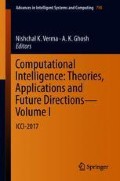Abstract
A sudden increase in the number of deaths over the past few years by slipping and falling, especially in case of patients in hospitals and aged people at homes, is a serious concern and calls for the need of an autonomous system for detection of fall and alerting caretaker in case of emergency. We propose an algorithm which, first, derives features from an input stream of data sensed and uses it in learning of our system and further, provides it with the capability of classifying a sequence into either fall or activity of daily living sequence implemented using support vector machine. We propose a space and time efficient system, minimizing its cost by using only 3-axial accelerometer as sensor. Choice of type and number of features along with their operational complexity is a crucial factor for our system. Performance analysis is done by first training our system and then testing its accuracy in classifying test sequences using machine learning algorithm.
Access this chapter
Tax calculation will be finalised at checkout
Purchases are for personal use only
References
Ahmed, H., Tahir, M.: Improving the accuracy of human body orientation estimation with wearable imu sensors. IEEE Trans. Instrum. Measur. 66(3), 535–542 (2017)
Aziz, O., Musngi, M., Park, E.J., Mori, G., Robinovitch, S.N.: A comparison of accuracy of fall detection algorithms (threshold-based vs. machine learning) using waist-mounted tri-axial accelerometer signals from a comprehensive set of falls and non-fall trials. Med. Bio. Eng. Comput. 55(1), 45–55 (2017)
Bourke, A., Obrien, J., Lyons, G.: Evaluation of a threshold-based tri-axial accelerometer fall detection algorithm. Gait Posture 26(2), 194–199 (2007)
Bourke, A.K., Lyons, G.M.: A threshold-based fall-detection algorithm using a bi-axial gyroscope sensor. Med. Eng. Phys. 30(1), 84–90 (2008)
Cornacchia, M., Ozcan, K., Zheng, Y., Velipasalar, S.: A survey on activity detection and classification using wearable sensors. IEEE Sens. J. 17(2), 386–403 (2017)
Dai, J., Bai, X., Yang, Z., Shen, Z., Xuan, D.: PerFallD: a pervasive fall detection system using mobile phones. In: 2010 8th IEEE International Conference on Pervasive Computing and Communications Workshops (PERCOM Workshops), pp. 292–297 . IEEE (2010)
Hakim, A., Huq, M.S., Shanta, S., Ibrahim, B.: Smartphone based data mining for fall detection: analysis and design. Procedia Comput. Sci. 105, 46–51 (2017)
Hwang, J.Y., Kang, J., Jang, Y.W., Kim, H.C.: Development of novel algorithm and real-time monitoring ambulatory system using Bluetooth module for fall detection in the elderly. In: 26th Annual International Conference of the IEEE Engineering in Medicine and Biology Society, IEMBS’04, vol. 1, pp. 2204–2207. IEEE (2004)
Kangas, M., Konttila, A., Winblad, I., Jamsa, T.: Determination of simple thresholds for accelerometry-based parameters for fall detection. In: 29th Annual International Conference of the IEEE Engineering in Medicine and Biology Society, EMBS 2007, pp. 1367–1370. IEEE (2007)
Khan, S.S., Karg, M.E., Kulić, D., Hoey, J.: Detecting falls with x-factor hidden Markov models. Appl. Soft Comput. 55, 168–177 (2017)
Lindemann, U., Hock, A., Stuber, M., Keck, W., Becker, C.: Evaluation of a fall detector based on accelerometers: a pilot study. Med. Biol. Eng. Comput. 43(5), 548–551 (2005)
Mubashir, M., Shao, L., Seed, L.: A survey on fall detection: principles and approaches. Neurocomputing 100, 144–152 (2013)
Noury, N., Fleury, A., Rumeau, P., Bourke, A., Laighin, G., Rialle, V., Lundy, J.: Fall detection-principles and methods. In: 29th Annual International Conference of the IEEE Engineering in Medicine and Biology Society, 2007, EMBS, pp. 1663–1666. IEEE (2007)
Panhwar, M., Shah, S.M.S., Shah, S.M.Z.S., Shah, S.M.A., Chowdhry, B.S.: Smart phone based fall detection using auto regression modeling in a non-restrictive setting. Indian J. Sci. Technol. 10(5), (2017)
Shastry, M.C., Asgari, M., Wan, E.A., Leitschuh, J., Preiser, N., Folsom, J., Condon, J., Cameron, M., Jacobs, P.G.: Context-aware fall detection using inertial sensors and time-of-flight transceivers. In: 2016 IEEE 38th Annual International Conference of the Engineering in Medicine and Biology Society (EMBC), pp. 570–573. IEEE (2016)
Tolkiehn, M., Atallah, L., Lo, B., Yang, G.Z.: Direction sensitive fall detection using a triaxial accelerometer and a barometric pressure sensor. In: 2011 Annual International Conference of the IEEE Engineering in Medicine and Biology Society, EMBC, pp. 369–372. IEEE (2011)
Vavoulas, G., Pediaditis, M., Spanakis, E.G., Tsiknakis, M.: The mobifall dataset: An initial evaluation of fall detection algorithms using smartphones. In: 2013 IEEE 13th International Conference on Bioinformatics and Bioengineering (BIBE), pp.1–4. IEEE (2013)
Vavoulas, G., Pediaditis, M., Chatzaki, C., Spanakis, E.G., Tsiknakis, M.: The MobiFall dataset: fall detection and classification with a smartphone. In: Artificial Intelligence: Concepts, Methodologies, Tools, and Applications, IGI Global, pp. 1218–1231 (2017)
Vogelhuber, T., Fleming, G., Moore, L., Haggerty, M., Hanlon, P., Bartone, C.G.: Prize-winning ohio university students present their work on an antenna for body area networks [education corner]. IEEE Antennas Propag. Mag. 59(1), 116–126 (2017)
Wang, Y., Wu, K., Ni, L.M.: Wifall: device-free fall detection by wireless networks. IEEE Trans. Mob. Comput. 16(2)(2016)
Zhao, K., Jia, K., Liu, P.: Fall detection algorithm based on human posture recognition. In: Advances in Intelligent Information Hiding and Multimedia Signal Processing: Proceeding of the Twelfth International Conference on Intelligent Information Hiding and Multimedia Signal Processing, 21–23 Nov 2016, Kaohsiung, Taiwan, vol. 2, pp.119–126. Springer (2017)
Author information
Authors and Affiliations
Corresponding author
Editor information
Editors and Affiliations
Rights and permissions
Copyright information
© 2019 Springer Nature Singapore Pte Ltd.
About this paper
Cite this paper
Ranakoti, S. et al. (2019). Human Fall Detection System over IMU Sensors Using Triaxial Accelerometer. In: Verma, N., Ghosh, A. (eds) Computational Intelligence: Theories, Applications and Future Directions - Volume I. Advances in Intelligent Systems and Computing, vol 798. Springer, Singapore. https://doi.org/10.1007/978-981-13-1132-1_39
Download citation
DOI: https://doi.org/10.1007/978-981-13-1132-1_39
Published:
Publisher Name: Springer, Singapore
Print ISBN: 978-981-13-1131-4
Online ISBN: 978-981-13-1132-1
eBook Packages: Intelligent Technologies and RoboticsIntelligent Technologies and Robotics (R0)

